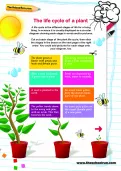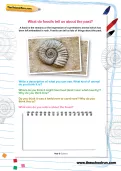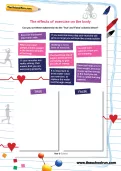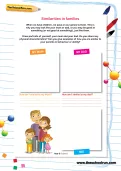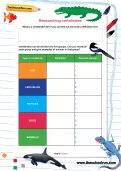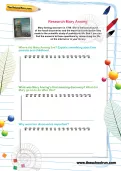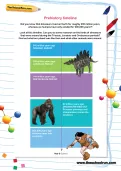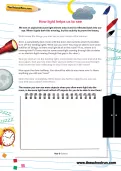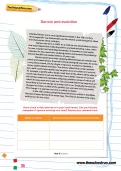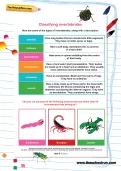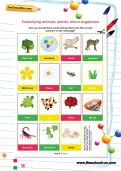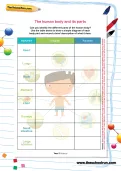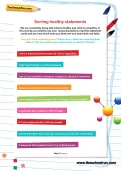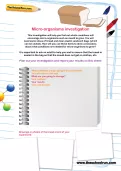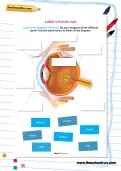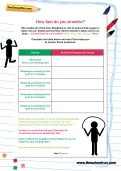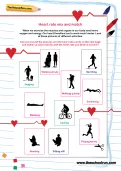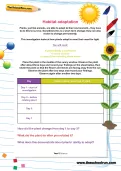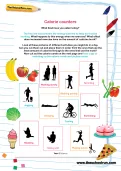A life cycle is the different stages of life for a living thing. Fill in a circular life cycle diagram to show you understand how a plant's life cycle works.
or
Register to add to your saved resources
Already a subscriber? to view this content.
A fossil is the remains or the impression of a prehistoric animal which has been left embedded in rock. Fossils can tell us lots of things about the past. Have a look at this image and see if you can answer the following questions.
or
Register to add to your saved resources
Already a subscriber? to view this content.
Can you sort these statements about the effects of exercise into the ‘True’ and ‘False’ columns below?
or
Register to add to your saved resources
Already a subscriber? to view this content.
Smoking and drinking alcohol are not illegal, but cigarettes and too much alcohol are very bad for your health. Can you match these smoking-related words to their definitions below?
or
Register to add to your saved resources
Already a subscriber? to view this content.
When we have children, we pass on our genes to them. This is why you may look like your mum or dad, or you may be good at something (or not good at something!), just like them. Draw portraits of yourself, your mum and your dad. Do you share any physical characteristics? Can you give examples of how you are similar to your parents in behaviour or ability?
or
Register to add to your saved resources
Already a subscriber? to view this content.
Vertebrates can be divided into five groups. Can you research each group and give examples of animals in that group?
or
Register to add to your saved resources
Already a subscriber? to view this content.
Mary Anning was born in 1799. She is famous because of her fossil discoveries and the important contribution they made to the scientific study of prehistoric life. See if you can find the answers to these questions by researching her life on the internet or in your library.
or
Register to add to your saved resources
Already a subscriber? to view this content.
Did you know that dinosaurs lived on Earth for roughly 200 million years, whereas we humans have only existed for 200,000 years?! Look at this timeline. Can you do some research on the kinds of dinosaurs that were around during the Triassic, Jurassic and Cretaceous periods? Find out what our planet was like then and what other animals were around.
or
Register to add to your saved resources
Already a subscriber? to view this content.
We see an object because light shines onto it and is reflected back into our eye. When it gets dark this evening, try this activity to prove the theory.
or
Register to add to your saved resources
Already a subscriber? to view this content.
Have you heard about Darwin's theories on evolution? Have a look on the internet or in your local library. Can you find any examples of species evolving over time? Record your research.
or
Register to add to your saved resources
Already a subscriber? to view this content.
Can you cut out each of the following pictures and say which class of invertebrates they belong to?
or
Register to add to your saved resources
Already a subscriber? to view this content.
Do you know the difference between animals, plants, micro-organisms? See if you can you put all these in the correct group.
or
Register to add to your saved resources
Already a subscriber? to view this content.
Can you identify the different parts of the human body? Use the table to draw a simple diagram of each body part and record a brief description of what it does.
or
Register to add to your saved resources
Already a subscriber? to view this content.
We are constantly being told what is healthy and what is unhealthy. In this activity you need to use your reasoning skills to read the statement cards and sort out which ones you think are true and which are false.
or
Register to add to your saved resources
Already a subscriber? to view this content.
This investigation will help you find out which conditions will encourage micro-organisms such as mould to grow.
or
Register to add to your saved resources
Already a subscriber? to view this content.
Look at this diagram of the eye. Do you recognise all the different parts? Use the labels below to finish off the diagram.
or
Register to add to your saved resources
Already a subscriber? to view this content.
We breathe all of the time. Breathing is vital to ensure that oxygen is taken into our bodies and harmful carbon dioxide is taken out of our body… but how fast do we breathe? When does this change? Why? Complete the table and see if this helps you to answer these questions.
or
Register to add to your saved resources
Already a subscriber? to view this content.
When we exercise the muscles and organs in our body need more oxygen and energy. Our heart therefore has to work much harder. Look at these pictures of different activities. Can you cut out the pictures and the heart rate cards and match up each activity with the heart rate you think is correct?
or
Register to add to your saved resources
Already a subscriber? to view this content.
Plants, just like animals, are able to adapt to their environment – they have to do this to survive. Sometimes this is a short-term change; they can also evolve to change permanently. This investigation looks at how plants adapt to meet their need for light.
or
Register to add to your saved resources
Already a subscriber? to view this content.
Look at these pictures of different activities you might do in a day. Can you cut them out and place them in order from the ones that use the least amount of calories through to the ones that use the most?
or
Register to add to your saved resources
Already a subscriber? to view this content.
